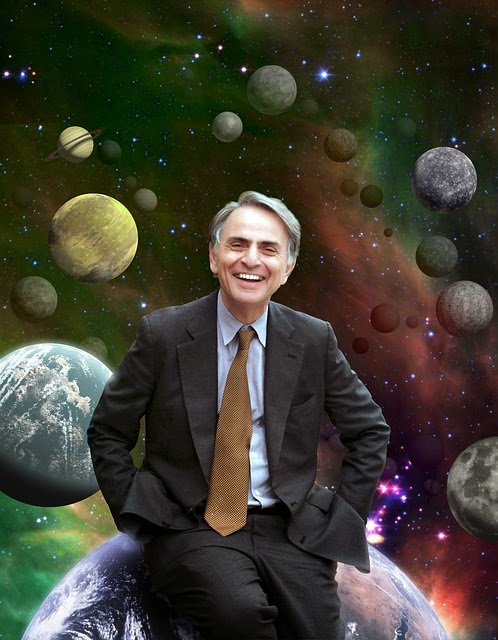Explorations of Our Galactic Home
 |
| Carl Sagan, 1934-1996 |
“Exploration is in our nature. We began as wanderers, and we are wanderers still. We have lingered long enough on the shores of the cosmic ocean. We are ready at last to set sail for the stars.”
- Carl Sagan
Most people are passingly familiar with Star Trek or, at the very least, with Mr. Spock—the pointy-eared, green-blooded Vulcan whose catchphrase is “Live long and prosper.” Leonard Nimoy, the actor who brought Spock to life, passed away February 27 and with him, a legacy of kindness and humanity like few others. His fights for equal pay for fellow Star Trek castmates as well as lending his voice to the cause of diversity within the cast made for an impressive life, both behind and on the screen.
With his passing, I felt inspired to learn more about our galaxy. In the words of Carl Sagan, “We are a way for the cosmos to know itself.” Studying the stars is a way to study where we came from and what makes us all up, the things that sew together the universe as we know it. Whether you’re a novice backyard astronomer or an advanced stargazer, the Birmingham Public Library has the resources you need when it comes to the cosmos.
Carl Sagan’s Cosmos: A Personal Journey, is a 1980 thirteen-part miniseries wherein Sagan himself walks us through the story of the universe, from the smallest atoms to the biggest celestial bodies. His book by the simple title of Cosmos, published in 1985, reiterates much and expounds on topics of the miniseries.
Or you may be familiar with the sequel to Sagan’s series: the 2014 Cosmos: A Spacetime Odyssey, hosted by Neil DeGrasse Tyson and recently aired on Fox. Building on the foundation of Sagan’s, it comes with the added bonus of corrected and newly-discovered information about our universal home.
Maybe you’re interested in seeing what NASA (or other countries’) astronauts are up to for another astounding glimpse of life outside of Earth. One of the more fascinating aspects of the modern age is the ability for astronauts to tweet from outer space itself, something I certainly never imagined as a possibility when I was a child on the heels of the Challenger disaster.
From the black-and-white depictions of Neil Armstrong and Buzz Aldrin walking on the moon to astronauts tweeting pictures of the Earth from miles and miles away (in color!, and often with the hashtag #earthart), space knowledge and travel has come light-years since we first began our search thousands of years ago. Come and see us. BPL has everything you need to get started on your own personal cosmic journey (found mostly in the 520s).
Books
The New Astronomy Guide: Stargazing in the Digital Age
The Handy Astronomy Answer Book
Celestial Geometry: Understanding the Astronomical Meanings of Ancient Sites
Hubble: The Mirror on the Universe
Cosmos [by Carl Sagan, with reflections by Neil DeGrasse Tyson and foreword by Ann Druyan]
DVDs
Cosmos: A Spacetime Odyssey
How the Universe Works, season 1(2011)
How the Universe Works, season 2 (2014)
Social Media
NASA’s APOD - website
NASA’s APOD (Astronomy Pic of the Day) - Twitter
Sky & Telescope - Twitter
NASA Astronauts - Twitter
Terry W. Virts (American astronaut aboard the ISS) - Twitter
Sam Cristoforetti (Italian astronaut aboard the ISS) - Twitter
Reid Wiseman (American astronaut, recently returned from ISS) - Twitter
“If I finish a book a week, I will read only a few thousand books in my lifetime, about a tenth of a percent of the contents of the greatest libraries of our time. The trick is to know which books to read.”
- Carl Sagan
Lynda Tidmore
Business, Science & Technology/Social Sciences
Central Library
Comments